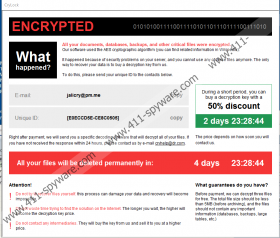CryLock Ransomware Removal Guide
CryLock Ransomware is the kind of malware that you do not want to have to deal with. It slithers in silently. It encrypts personal files. It makes promises that are unlikely to be kept. Unfortunately, even when the victims of this malware realize that they are dealing with cybercriminals, they might feel stuck, and that is something that might lead them to making risky moves. The riskiest of all moves is paying the ransom that the attackers request in return for a decryptor that, allegedly, can be used to recover all of the files that the malware encrypts. Who can force cybercriminals to provide you with a decryptor? No one, and so do not be naive thinking that your payment guarantees decryption. At this point, we cannot help you restore files, but we can help you delete CryLock Ransomware. Note that the sooner you remove this infection, the sooner your operating system will become safe again.
Are you familiar with an infection named Cryakl Ransomware? Well, this is the predecessor of CryLock Ransomware, according to our research team. This malware is not much different from HAT Ransomware, Josephnull Ransomware, Smpl Ransomware, and other similar threats. They all use stealth techniques to slither in, they all encrypt files, and they all demand ransom payments. To slither in, CryLock Ransomware has to find an unguarded system, as those with robust anti-malware systems protecting them are much harder (hopefully, impossible) to invade. The ransomware is unlikely to have specific targets, and so the attacker behind it is most likely to shoot in the dark. They might send spam emails with the infection’s launcher attached as a harmless file. They might build irresistible bundled downloaders. They can also use tools to detect vulnerabilities withing systems. Whichever way this malware gets in, it always encrypts personal files, and it always adds the “.[jalicry@pm.me].[unique number]” extension to their names.
On the Desktop, CryLock Ransomware drops a file named “how_to_decrypt.hta.” It opens a message, using which the attackers are trying to convince you to communicate with them. The first email address that is listed is jalicry@pm.me, but there is also a backup email, cryhelp@dr.com. We do not recommend sending a message to either of them because we do not think that emailing cybercriminals is a good idea. But what are you to do if you cannot replace the corrupted files using safely stored backups or legitimate decryptors? You might have hope that cybercriminals will do the right thing and provide you with a decryptor once you pay the ransom (the exact sum is unknown), but trusting cybercriminals is like playing with fire. It is bound to burn you. Even if you were given a decryptor – which is unlikely to happen – they could gain the ability to scam you over and over again once they know your email address. Hopefully, you do not need twist your head to figure out what the best thing to do is because backups exist somewhere safe, and you can use them after removing CryLock Ransomware to replace the lost files.
As you can see, we do not have a very specific CryLock Ransomware removal guide. Unfortunately, we simply cannot know where the .exe file of this malware exists on your system. Perhaps it is located on the Desktop, in the Downloads folder, or in the %TEMP% directory, but we cannot know for sure. That being said, if you executed this malware yourself, you might be able to locate it. There are no other components that you need to worry about, but of course, we advise removing the ransom note file too. In case you have contacted the attackers, please be careful about the emails you receive from now on. And if you have decrypted the files, do not forget to delete CryLock Ransomware anyway. Finally, figure out how to secure your system and files in the future. It is easiest to manage files by creating copies and storing them online or on secure external drives. When it comes to Windows security, implementing trusted anti-malware software is important. The best part is that this software can also automatically delete existing threats.
How to delete CryLock Ransomware
- If you can find the {random name}.exe file that launched the infection, right-click it and choose Delete.
- Move to the Desktop and then right-click and Delete the file named how_to_decrypt.hta.
- Once you think that all malicious files are gone, quickly Empty Recycle Bin.
- Implement a legitimate malware scanner to help you scan your system and check for malware leftovers.
CryLock Ransomware Screenshots:


